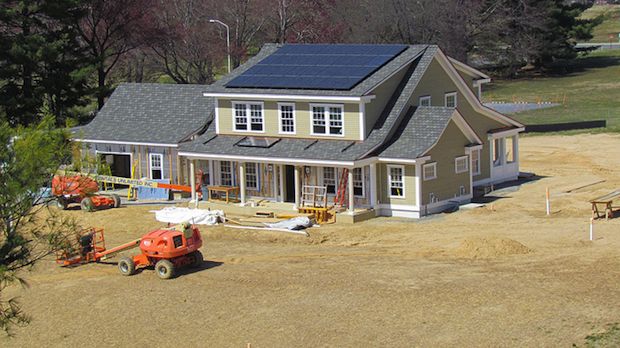
The mister and I have long defended our choice to live in a cantankerous pre-Depression house by saying, “They don’t build them like they used to.” (Plus, it has a laundry chute. Don’t laugh unless you’ve had one.)
But times change, and “they” are coming up with house-building innovations that make my old house look like the creaky, leaky, loveable curmudgeon it is. And “they” are a disparate network of architects, scientists, engineers, and builders thinking outside the Cape Cod saltbox about energy and resource consumption, lifestyle, and technology.
Why does energy consumption at home matter? In the US, residential consumption of electricity accounted for about 16% of delivered energy, based on data in a report and forecast published on the US Energy Information Administration website. (The website is dense with data and analysis.) Stanford architecture student Derek Ouyang makes an eloquent case in a TEDxStanford talk (also below) though, for the more subtle point that residential consumption is about personal stewardship of common resources, “It’s time to change our culture and values around energy.”
There is growing interest in the idea of a “net zero energy residence.” NZERs are designed with energy-generating systems such as solar panels and geothermal systems (and, presumably, SOFC someday), as well as highly energy-efficient systems with zoned HVAC, LED and CF lighting, and in-home smart grids to run appliances and household electronics and equipment.
The National Institute of Standards and Technology built an actual home (image above; Credit: NIST) to net-zero specs (pdf) on its campus in Gaithersburg, Md., to test the NZER proposition for a simulated family of four. The agency realized that most people want to live in a house that does not look too weird, so it built the NIST home to look much like one you would find in any suburban new housing development. The 2-story, 2,700 square foot home incorporates commercially available systems but generates all of its own electricity plus a little to share. Just today, NIST released data showing that, since the experiment started in July 2013, the house has been a “net exporter” of energy, producing 623 kWh more than it needed to support its virtual suburban family. It will be interesting to see how the house does during the imminent dark and cold of fall and winter.
Meanwhile, out in California, the DOE is hosting its sixth Solar Decathlon competition. Started in 2002, DOE puts the challenge out to college teams to “design, build, and operate solar-powered houses that are cost-effective, energy-efficient, and attractive.” Judges take into account aesthetics such as curb appeal and design, as well as affordability, efficiency, and energy generation.
This year’s competition is in Irvine, Calif., over two weekends—Oct. 3–6 and Oct. 10–13. Twenty teams from the US, Canada, and Europe have entries, including some schools from such unsunny locales as Vermont, Ontario, Austria, and North Carolina. Each school has drawings and information about their home on the Decathlon’s website. The students offer creative and interesting ideas from an interior design perspective as well as from an energy perspective. In fact, my first reaction is to the design elements, which is part of the point—we have like a house well enough to make it a home.
Ouyang says in his talk, “I hope that my generation will be the one to finally say that the ignorance [about energy and resources] stops here.” I hope he is wrong. Let’s make it all generations—from the large, powerful, and wealthy baby boom generation I belong to, to Ouyang’s millennial generation, to my toddling grandchildren of the as-yet unnamed generation.
That said, however, I do think Ouyang’s generation has more of the unfettered mental freedom unique to youth to pose questions in a new way. In his TEDx talk, for example, he asks, why not design homes for “sustainable people” instead of “sustainable systems?” Rather than think about how to power a house, why not think about how to empower its residents? This kind of thinking led the Stanford team to design a “core” that serves as the power, air, and water plants—or, as Ouyang says, the muscle, brain, and heart of the home. The rest of the structure is built in modular fashion with systems driven by the core that help residents control and track their consumption in real time.
Ouyang’s 10-minute talk is well worth watching if you are interested in the intersection of sustainability, energy, and architecture. Poised and articulate, this young man already is emerging as a thought leader.
